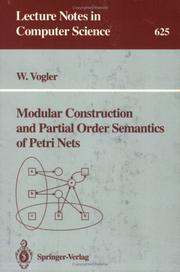| Listing 1 - 1 of 1 |
Sort by
|

ISBN: 0387557679 3540557679 3540472827 Year: 1992 Volume: 625 Publisher: Berlin : Springer-Verlag,
Abstract | Keywords | Export | Availability | Bookmark
 Loading...
Loading...Choose an application
- Reference Manager
- EndNote
- RefWorks (Direct export to RefWorks)
Petri nets are a well-known model for parallel systems, used for both applications and theoretical studies. They can be used for specification, modelling, and analysis, and offer a graphical representation and a clear view of concurrency. For the design of large systems, modular construction is indispensible, and considerable effort has been spent on studying themodular construction of Petri nets. This book studies the modular construction of nets, and in particular the top-down design of nets by action refinement. Suitable behavior descriptions are presented and special care is taken to justify these descriptions by showing that theyare necessary under reasonable specification requirements. In particular, itis shown that partial-order semantics is necessary to support action refinement.
Parallel processing (Electronic computers) --- Parallelle verwerking (Computers) --- Petri nets --- Petrinetten --- Réseaux de Petri --- Traitement parallèle (Ordinateurs) --- Parallélisme (Informatique) --- Réseaux de Pétri --- 681.3*D22 --- 681.3*F12 --- 681.3*F32 --- 681.3*F43 --- Graph theory --- Nets (Mathematics) --- High performance computing --- Multiprocessors --- Parallel programming (Computer science) --- Supercomputers --- Tools and techniques: decision tables; flow charts; modules and interfaces; programmer workbench; software libraries; structured programming; top-down programming; user interfaces (Software engineering) --- Modes of computation: alternation and nondeterminism; parallelism; probabilistic computation; relations among modes; relativized computation --- Semantics of programming languages: algebraic approaches to semantics; denotational semantics; operational semantics (Logics and meanings of programs)--See also {681.3*D31} --- Formal languages: algebraic language theory; classes defined by grammars or automata or by resource-bounded automata; operations on languages (Mathematical logic and formal languages)--See also {681.3*D31} --- 681.3*F43 Formal languages: algebraic language theory; classes defined by grammars or automata or by resource-bounded automata; operations on languages (Mathematical logic and formal languages)--See also {681.3*D31} --- 681.3*F32 Semantics of programming languages: algebraic approaches to semantics; denotational semantics; operational semantics (Logics and meanings of programs)--See also {681.3*D31} --- 681.3*F12 Modes of computation: alternation and nondeterminism; parallelism; probabilistic computation; relations among modes; relativized computation --- 681.3*D22 Tools and techniques: decision tables; flow charts; modules and interfaces; programmer workbench; software libraries; structured programming; top-down programming; user interfaces (Software engineering) --- Parallélisme (Informatique) --- Réseaux de Pétri --- Petri nets. --- Computer network architectures. --- Systems theory. --- Software engineering. --- Computer science. --- Computer System Implementation. --- Systems Theory, Control. --- Software Engineering. --- Computation by Abstract Devices. --- Mathematical Logic and Formal Languages. --- Informatics --- Science --- Computer software engineering --- Engineering --- Architectures, Computer network --- Network architectures, Computer --- Computer architecture
| Listing 1 - 1 of 1 |
Sort by
|

 Search
Search Feedback
Feedback About UniCat
About UniCat  Help
Help News
News